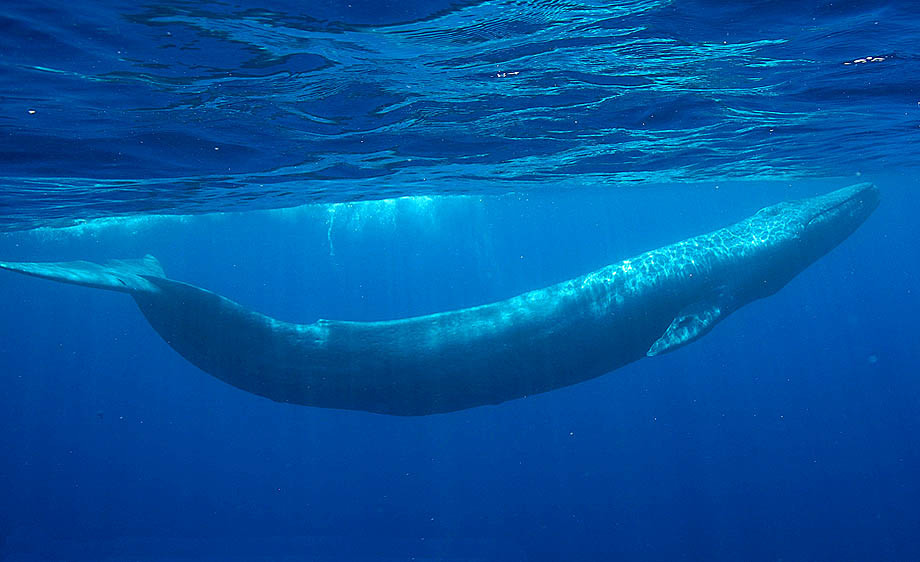Blue Whale

Find A Hotel in Los Cabos
Fantastic deals on hotels in Los Cabos with our booking partners. Amazing discounts on over 100 properties, instant reservation and user reviews/ratings to guarantee you get the hotel you want, when you want it. In many cases you PAY NOTHING now...check it out here!
Blue whales are a blue-grey color with a tapered body, small dorsal fin and flat head. They look their most blue whilst under water, for obvious reasons. Their underbellies take on a yellowish hue from the millions of microorganisms that take up residence in their skin.
Three distinct species of Blue whale can be found in the North Atlantic, Pacific and Indian Oceans, and the Sea of Cortez is a world renowned location to view these magnificent animals, probably the largest animal ever to have lived on Planet Earth. Scientists think that between 200 and 300 animals winter in the Sea of Cortez, mostly around Loreto, and it is there they give birth to their calves. Female Blue whales typically give birth every 2-3 years and calves are weaned at about six months and reach maturity at about 8 years of age.
An adult Blue whale can reach a length of 100 feet and weigh nearly 190 tons; their tongues alone can weigh as much as an elephant; their hearts, as much as an automobile.
They reach these awesome dimensions on a diet composed almost exclusively of tiny shrimplike animals called krill occasionally supplemented by squid. During certain times of the year, a single adult Blue whale consumes about 4 tons (3.6 metric tonnes) of krill a day. They feed at a depth of about 330 feet and usually only surface-feed at night.
Blue whales are baleen whales, which means they have fringed plates of fingernail-like material, called baleen, attached to their upper jaws. The giant animals feed by first gulping an enormous mouthful of water, expanding the pleated skin on their throat and belly to take it in. Then that massive tongue forces the water out through the thin, overlapping baleen plates. Thousands of krill are sieved from the seawater and then swallowed.
Blue whales live in all the world's oceans and they often spend summers feeding in polar waters and undertake lengthy migrations as winter arrives. Most Blue whales live their lives as individuals or they may travel with one other partner. Their only natural predator is thought to be the Orca.
Graceful swimmers, they cruise the ocean at more than five miles an hour (eight kilometers an hour), but accelerate to more than 20 miles an hour (32 kilometers an hour) when they are agitated. Local Cabo fishermen see them occasionally and say that they cannot keep up with the animals for more than a few minutes when they are traveling with purpose.
Blue whales are among the loudest animals on the planet. They emit a series of pulses, groans, and moans, and it’s thought that, in good conditions, Blue whales can hear each other up to 1,000 miles (1,600 kilometers) away. Scientists think they use these vocalizations not only to communicate, but, along with their excellent hearing, to sonar-navigate the lightless ocean depths.
Really Big Babies
Blue whale calves enter the world already ranking among the planet's largest creatures. After about a year inside its mother's womb, a baby Blue whale emerges weighing up to 3 tons (2.7 metric tons) and stretching to 25 feet (8 meters). It gorges on nothing but mother's milk and gains about 200 pounds (91 kilograms) every day for its first year. Recent studies have shown that calving rates among the remaining population are dropping with only 22 calves born to 450 studied individuals.
Blue whales are among Earth's longest-lived animals. Scientists have discovered that by counting the layers of a deceased whale's waxlike earplugs, they can get a close estimate of the animal's age. The oldest individual found using this method was determined to be around 110 years old. Their average lifespan is estimated at around 80 to 90 years.
Between 10,000 and 25,000 Blue whales are believed to still swim the world's oceans but no one can be certain what the exact population is, however there is general agreement that it is either in slow decline or static. Aggressive hunting in the 1900s by whalers seeking whale oil drove them to the brink of extinction. Between 1900 and the mid-1960s, some 360,000 blue whales were slaughtered. They finally came under protection with the 1966 International Whaling Commission, but they've managed only a minor recovery since then. Some theories about this suggest that the noise from shipping is interfering with their ability to locate each other in the ocean.
Many Blue whales are injured or die each year from impacts with large ships. Blue whales are currently classified as endangered on the World Conservation Union (IUCN) Red List.
The best time to see them in Los Cabos is between January and May with February - April the peak months. The best place is in the Loreto Marine Park and tours and trips can be organized from Cabo San Lucas.